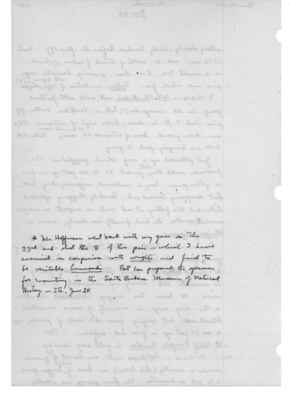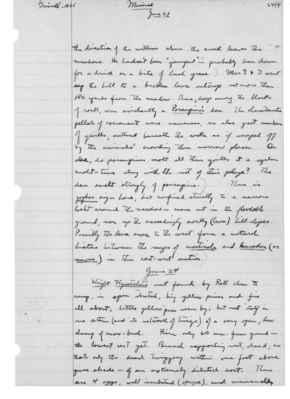Pages That Mention 1925-06-24
1925: Joseph Grinnell's field notes
S2 Page 35
Collector: Grinnell - 1925 Location: Unspecified (but presumably either proximate to Mineral or having left for elsewhere). Date: June 24 Page Number: No formal page #.
* Mr. Hoffmann went back with my gun on the 23nd and shot the male of this pair - which I have examined in comparison with wrighti and find to be veritable hammondi. Rett has prepared the specimen for mounting in the Santa Barbara Museum of Natural History - J. G., June 24.
S2 Page 40
Collector: Grinnell - 1925 Location: Mineral Date: June 23-24 Page Number: 2494
the direction of the willows where the creek leaves the meadows. He hadn't been "jumped" - probably been down for a drink or a bit of lush grass. Mrs. G. & I went up the hill to a broken lava outcrop not more than 150 yards from the meadow. There, deep among the blocks of rock, was evidently a Porcupine's den. The characteristic pellets of excrement were numerous, as also great numbers of quills, scattered beneath the rocks as if scraped off by the animals' crowding the narrow place. Or else, do porcupines molt all their quills at a regular molt-time along with the rest of their pelage? The den smelt strongly of porcupine. There is gopher sign here, but confined strictly to a narrow belt around the meadow - none out in the floodable ground, nor up in the exceedingly rocky (lava) hill-slopes. Possible the lava areas to the west form a natural hiatus between the ranges of monticola and leucodon (or navus) in this east-west section.
June 24 Wright Flycatcher's nest found by Rett close to camp, in open stretch, big yellow pines and firs all about; little yellow pines near by; but nest itself in one stem (and its network of twigs) of a very open, low clump of snow-bush. Rim only 6/0 mm. from ground the lowest nest yet. Branch supporting nest, dead; so that only the dead twiggery within one foot above gives shade - of an extremely diluted sort. There are 4 eggs, well incubated (opaque), and unusually
S2 Page 41
Collector: Grinnell - 1925 Location: Mineral Date: June 24 Page Number: 2495
in that each has scattering ^fine dots, mostly about the big end, of dark brown. The [female symbol] on the nest allowed me to get my hand within 2 feet of her, as I had an excellent view, proving her ^to be wrighti. Her tail is abnormal in that only two old feathers remain, the nest being new and only about 2/3 grown out. The nest is usual size and construction and nests chiefly within the forks of the main ceanothus stem which is 5/8 in. thick just below the forking. Taken nest + 3/4 + [female symbol] ^parent. 9 a.m.-- Mr. Hoffmann shot a (female) Three-Toed Woodpecker at 6:20 this morning out of a dead stub on ridge (Viola trail) hardly 10 minutes walk from camp, therefore not higher than 5200 ft.! 10:30 a.m. Hoffmann and I up Viola Trail at about 5500 ft. listening to Hammond (?) [sic] Flycatcher on chosen singing perch, which is very topmost snag-end of dead-topped fir. Estimated height from ground 135 feet. Bird plainly seen - breast to sun, appearing white. Bird continually shifts body, most frequently head, from side to side. Head thrown back with utterance of notes. Complete "song" has three elements: se-'put [uttered rapidly], taur-r-rp [roughly burred], tseep´ [rising inflection]. More of interval between first and second than second and third. Sometimes second and third interchanged. At camp - a Citellus douglasi, the first ground squirrel I have seen around Mineral, appeared on our "feeding log" this afternoon. It was a [female symbol] (teets showing) and she filled her cheek pouches bulgingly before she went off ^thru [sic] the snow-bush.
S2 Page 46
Collector: Grinnell - 1925 Location: Mineral Date: June 26 Page Number: 2500
nest found ten days ago, barely began; 3 eggs in nest day before yesterday.
6269 Wright Flycatcher [female symbol] with set 4/4 11.0 g. Had evidently had an accident by which a lot of feathers on back were lost, there being now in process of replacement. Possibly, delayed nesting due to this accident.
June 27 4 p.m. - Cassin Vireo's nest: rim 1750 mm. above ground; nest near end of drooping cedar branch, 7 feet out ^(on south side) from trunk of tree, which is 15 inches in diameter 3 feet from ground. Site about 10 yards from edge of willow bog on one side and less distance from heavy stand of firs, on the other side; lodgepole pines bordering bog close by. This nest was found partly built on the 15th, empty but seemingly completed on the 20th, now with 4 fresh or nearly fresh eggs ^(two of them) and female incubating. Taken, set 2/4. Male bird sang awhile, then went away. After I had waited 20 minute, the [female symbol] came quietly, and I "collected" her.
5 p.m. - Traill Flycatcher nest and set 1/4, taken. Nest, not quite completed, found on 20th, now four eggs, nearly or quite fresh; birds close about me. Nest in dense willow jungle. Rim only 1040 mm. above running water of creek, here entirely overgrown with matted willows. Nest on slanting stems, overtopped by fully 5 feet of lush willow growth.



